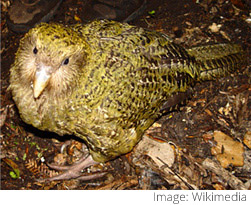 The kakapo is a member of the parrot family. Its name means "night parrot" in Maori. Kakapos used to be found through most of New Zealand. They are now extinct on the mainland and are only found on some small islands off New Zealand. The kakapo
is greeny-yellow in colour. It weighs about 3.5 kilos. The kakapo
can't fly; it lives
mainly on the ground, but it can climb trees. It comes out at night.
Kakapos eat the roots, seeds, fruits, flowers and leaves of many
different plants. Kakapos live more than 60 years. The kakapo is a member of the parrot family. Its name means "night parrot" in Maori. Kakapos used to be found through most of New Zealand. They are now extinct on the mainland and are only found on some small islands off New Zealand. The kakapo
is greeny-yellow in colour. It weighs about 3.5 kilos. The kakapo
can't fly; it lives
mainly on the ground, but it can climb trees. It comes out at night.
Kakapos eat the roots, seeds, fruits, flowers and leaves of many
different plants. Kakapos live more than 60 years.
Kakapos mate only once every three or four years. To attract a mate, the
males make a loud noise. They do this every
night for about three months. The female lays two or three eggs in a nest on the ground. She looks after the
eggs herself. When the chicks hatch, she has to go and find
food for them. This means she often leaves them alone and unprotected.
Kakapos
were plentiful until the arrival of the Europeans in the early nineteenth century.
The Europeans introduced cats, dogs and rats. The flightless kakapo and the unprotected kakapo chicks had little chance against
these predators.
By the 1970s, the kakapo was extinct on the mainland. But, thanks
to the efforts of conservationists, a few survive on offshore islands. The present population is estimated to be about 60. |